Animation &Articles on Animation &Independent Animation &Puppet Animation 06 Apr 2010 06:15 am
Don Sahlin
- After posting some stills from Ray Harryhausen’s Golden Voyage of Sinbad, I decided to look back and see if there were any other material I could post about 3D model animation.
I came upon this interview with Don Sahlin in Closeup Magazine, no. 2. published in 1976 by David Prestone.
(Bio)
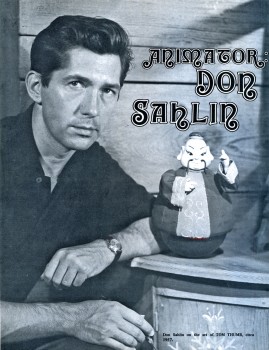 Born in Stratford, Connecticut, Don Sahlin (say—lien) was introduced to the world of marionettes at age eleven, when he saw a production of HANS BRINKER AND THE SILVER SKATES by the New York Marionette Guild.
Born in Stratford, Connecticut, Don Sahlin (say—lien) was introduced to the world of marionettes at age eleven, when he saw a production of HANS BRINKER AND THE SILVER SKATES by the New York Marionette Guild..
Joining the PUPPETEERS OF AMERICA organization, he was soon inundating many of that group’s members with letters of inquiry as to the correct method of constructing and performing marionette shows. This correspondence brought Don an offer from Rufus Rose (who, several years later, was to create all of the figures for the HOWDY DOODY televison show) to spend several weekends with Rose and his wife as an apprentice.
.
In 1946, Don started another apprenticeship of many years standing when he began working with Martin and August Stevens, who performed sophisticated marionette dramas of subjects like Macbeth, Joan of Arc, and Cleopatra.
.
A stint of Summer Stock in Rhode Island followed, when Don felt he would try his hand at the acting profession, but he soon became disenchanted with this form of theater work. In 1949, Don traveled to Hollywood, where he worked with puppeteerist Bob Baker, doing party shows for many of the movie stars there.
.
Don then returned home to perform a show of his own designing, SAINT GEORGE AND THE DRAGON, which played around the Connecticut area. Later jobs involved working with very large puppets accompanied by a symphonic orchestra, Chinese shadow plays, and, in 1950, a marionette version of the LAND OF OZ stories that Burr Tilstrom was preparing as a television pilot. Working for a year on this project, Don was then drafted into the army.
CLOSEUP: How did you first get involved with stop-motion animation?
.
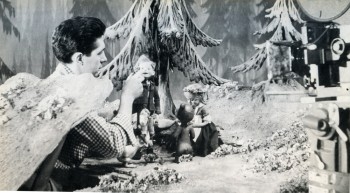 DON SAHLIN: When I got out of the Army in 1953, I had heard that Michael Myerberg was looking for puppeteers to work on HANSEL & GRET-EL. For some reason, he thought that puppeteers would make better animators than (stop-motion) animators! I was interviewed and got the job. I had to then go through a three-week training period with Myerberg in order to better acclimate myself with stop-motion. It was a very bizarre setup.
DON SAHLIN: When I got out of the Army in 1953, I had heard that Michael Myerberg was looking for puppeteers to work on HANSEL & GRET-EL. For some reason, he thought that puppeteers would make better animators than (stop-motion) animators! I was interviewed and got the job. I had to then go through a three-week training period with Myerberg in order to better acclimate myself with stop-motion. It was a very bizarre setup..
CU: Do you recall who sculpted the puppets?
.
DS: A man by the name of Jim Summers did the sculpturing. As I recall, they had a special machine shop where all the armatures were constructed. I’d give anything to own one of those armatures now. They were pieces of art.
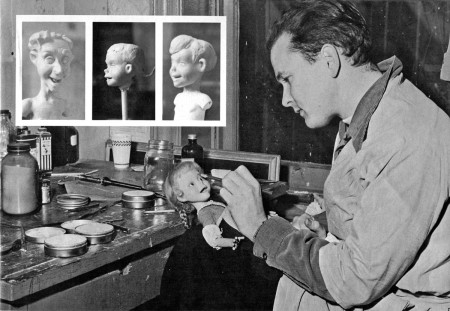
James Summers applies makeup to an almost finished Gretel.
Inset: Clay heads by Summers.
Below: Evil Witch Rosina Rubylips views herself
as portrayed in a preproduction sketch.
.
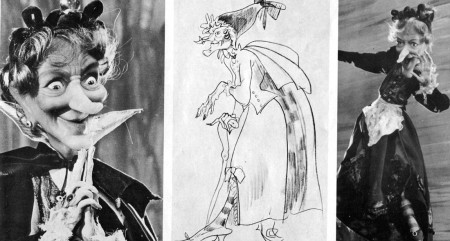
CU: Were they all ball-socket in construction?
DS: They were, but you’d press levers, which was really interesting. If you wanted to move the thigh, for instance, you’d press a little lever near the thigh area which would release it for a tiny movement. Removing pressure from the lever would freeze the puppet in position. As you may know, they were all held on the stage with electromagnets.
CU: Could you elaborate on how that was done? It’s interesting that Myerberg used that method of support as opposed to the tie-downs used by today’s animators. . .
DS: The base of the stage was all metal, and they had these strong electromagnets underneath. The puppets really clomped down on them. Of course, we’d have to break the electromagnetic field in order to move the legs to their next position. One night, as I remember, we were working on a very hard scene. Myerberg had a twenty-four-hour shift there, and the animation varied so greatly because people would come in and start animating where the day-shift had left off! We went out to dinner, and somehow, somebody had hooked the electromagnets into the main power source. Naturally, we killed all the lights as we went out. As we pulled the switch, we heard a series of plops. All the puppets had fallen over! We had to start the whole thing all over again! I quit twice on that film … I never got screen credit, because I quit before it ended.
CU: Here’s a quote from the book Puppet Animation in the Cinema: “The Kinemins used in HANSEL & GRETEL . . . were controlled by the use of electrical solenoids, and electromagnets in the feet. . . a system which is a closely-guarded trade secret…”
DS: (Laugh) That’s a lot of bunk, you know. The only thing “electronic” was the electromagnetic setup that held the puppets on the stage. Myerberg had a big panel upstairs where he’d use close-up heads that were wired to this big, blinking board. You’d turn knobs, but there was nothing electronic involved. There was simply a wire inside the mouth, and with a twist of a certain knob, the mouth would go “that way,” and so on. But it was all manual. Anything else that was said was a big put-on.
CU: A similar incident occurred with the publicity on Ray Harryhausen’s 7TH VOYAGE OF SIN-BAD, where the reporters of the media were quot-iny the producer on how the skeleton fight was “electronically” controlled . . .
DS: Nothing but press stuff, I would imagine. I’m glad you mentioned Harryhausen. God, I love his work. The one I saw recently again that I just adore was JASON AND THE ARGONAUTS. His work was absolutely superb. Classical mythology is such a wonderful area to explore. Why don’t they do more things like that?
CU: We’ve been asking ourselves the same question !
DS: Those skeletons were frightening! You know, I’ve learned to enjoy animation more now because I’ve been away from it for so long. But it’s a curious thing. Do you remember Trnka’s A MIDSUMMER NIGHT’S DREAM? I saw it again and fell asleep through most of the whole thing! I was just so aware of how long it took to do each scene that it fatigued me … But it was a beautiful film.
CU: Getting back to HANSEL & GRETEL. Who actually did the camerawork on it?
DS: That was a very strange thing. Myerberg hired Martin Munkasci to photograph the animation. He was one of the great still photographers and had done a lot of things with Garbo and so on. Oddly enough, Myerberg felt that since stop-motion was nothing but a series of still frames, a capable still photographer would be more appropriate to do the camerawork. It was a very strange rationale on his part. Martin knew virtually nothing about motion pictures. Fortunately, a very fine Acme camera was used which was simple to operate, and he would just line up the shots and photograph. Anyhow, we went nuts, going up and down opening and closing those trapdoors all night long, sitting under that stage! And those sets were gigantic. Many of the backdrops were paintings, but a lot of it was also dimensional.
CU: We know that Myerberg isn’t with us anymore. What became of his organization after HANSEL & GRETEL?
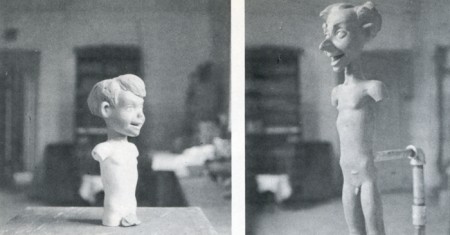
Above: The beginnings of the KINEMINS . . .
incomplete sculptures of Hansel and his father .
Below: Several puppet figures and a set (which predate all work
on HANSEL AND GRETEL) from ALADDIN AND THE WONDERFUL LAMP.
All sets and puppets for this project were put aside
once work began on the Humperdink musical.
.
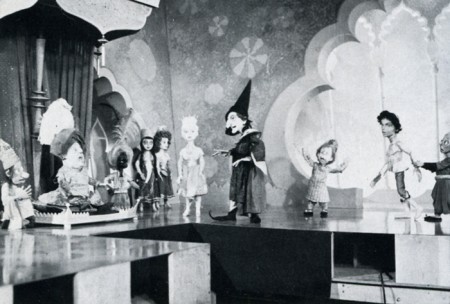
DS: Myerberg had all sorts of aspirations to do other things, but they never materialized. I think his sons own the film now.
CU: Where did you go from there?
DS: After I left Myerberg, I was in association with Kermit Love, who had also worked on the film. We were going to do a full-length motion picture Of Beatrix Potter’s TAILOR OF GLOUCESTER. It’s a charming story about a tailor and a Whole community of mice. We were going to animate all of the mice. We had the whole thing set up in London . . . Robert Donat was signed to play the lead role and Margaret Rutherford was also cast for the film. We began building the mice and we had some funding, although we hadn’t gotten to the point where we were able to build them all. Suddenly, we had a bad partnership and the whole project collapsed.
CU: Would the animated mice have been combined with live actors in the same scene?
DS: No, they would have been separate. I don’t really like it when they combine things, although Ray Harryhausen is a master at it. I wouldn’t want to do it in that way, but I respect what he does very much. Anyhow, I returned to the States when our TAILOR OF GLOUCESTER failed, and then got 3 call to go out and do work on TOM THUMB. That film, I think, was the most enjoyable thing I worked on during this period, because it was my first big job in Hollywood.
CU: How did you get involved with George Pal?
DS: At the time, 1 had been out in California working with a puppeteer friend of mine named Bob Baker. When TOM THUMB began, I was asked to build a little six-inch stop-motion marionette of Tom that they were going to use in the long shots. It was a funny thing. They said that he had to wear a fig leaf, so I carved this puppet with ball and socket joints, and he really looked naked. George was in England shooting in 1957, and decided that he wanted the puppet for a particular scene. But all my work was in vain, because the fig leaf that Tom wore covered almost his entire body. I had thought that the fig leaf would be in scale with his body, but that’s not the way it turned out. I think Wah Chang has the little Tom Thumb figure now, but I would love to own it. It was really an exquisite little puppet. It was all carved out of walnut, and I filled the legs with lead to make them heavy. It was never used in the closer shots, just distance stuff.
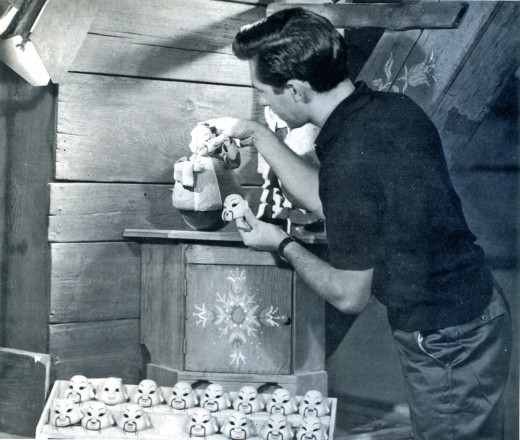
Two photos illustrating the replacement method of animation, utilized on TOM THUMB.
Instead of achieving changes of expression through manipulation of a stop-motion model’s
facial features, a series of heads are prodced, each head having a slightly different
expression on it. Changes are made by simply substituting one head for another.
Above: Don Sahlin placing a head on Con-fu-shun, and
Below: Numbered heads created for The Yawning Man animated by Gene Warren.
.
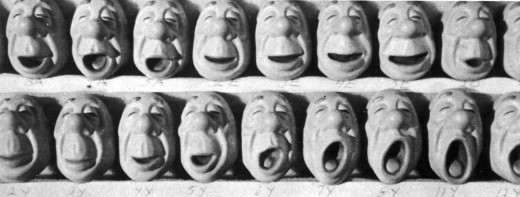
CU: How did you get to be a part of Project Unlimited?
DS: After I had carved the little stop-motion marionette, they started filming all of the animation sequences, but 1 had to go back to New York. Then Bob Baker called me from California and told me that they needed an animator. I talked to Wah Chang, I think it was, and he said, “Come on out and work for us!” 1 worked out at Project until about 1962. They wanted me to stay on, but Burr Tillstrom of Kukla, Fran and Ollie fame wanted me to come back to New York to work with him on a Broadway show. And it’s funny how fate is. I didn’t want to go; I really loved working at the studio, especially after THE TIME MACHINE. Anyhow, I did go to work for Burr on this small, cabaret-type show at the old Astor Hotel, but it soon folded. And like I say, 1 regretted leaving Hollywood, but I also met Jim Henson of the Muppets here in Mew York, and it led to probably my most successful period.
CU: Could you tell us just what you animated on TOM THUMB?
DS: I animated Con-fu-shun, a lot of the little guys that just popped up, and the Jack-in-the-Box. Gene Warren and I did all of the animation, just the two of us. Gene is a marvelous animator; he did the Yawning Man sequence. I spoke to Gene a little over a year ago, and I was so happy to find out that he does my favorite commercials—Chuck-wagon! To me, the most charming commercials ever done!
CU: What were some of the techniques used in animating Con-fu-shun?
DS: I remember Con-fu-shun was a very simple puppet. The armature was bolted to the stage and he just rocked. Occasionally, I think he got off for a couple of drop shots. The facial expressions were accomplished by replacing just the faces, which were made out of wax. We had a whole tray of all his faces. We’d just put on “E1″ or “E2,” or “Smile 1,” “Smile 2.” I know his eyes were not connected to the face; they were always independent. The faces just slipped on in perfect registration. I remember the little eye-pick I used for animating his eyes; it looked like a little hypodermic needle.
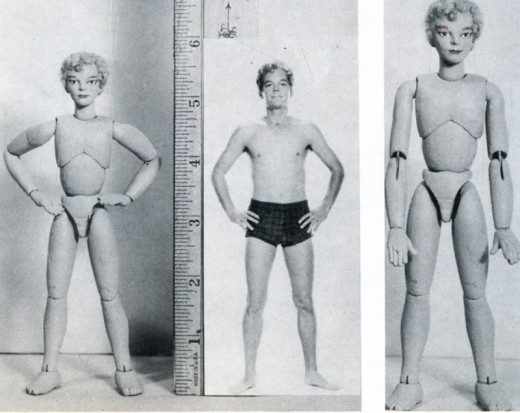
The TOM THUMB marionette created by Don Sahlin and used only in long shots.
CU: Did you have anything to do with constructing the large prop furniture, or giant hands and horse’s ears, that Russ Tamblyn was to interact with?
DS: No, that was all done at MGM, in England. Project Unlimited was a kind of neat little studio by itself, completely independent. Pal would do all of his stuff at MGM, but I wasn’t involved in the work done there, even on THE TIME MACHINE.
CU: You did some work on DINOSAURUS. Could you talk a bit about it? We know that,the models were built by Marcel Delgado, but little is known about who actually did what as far as the animation goes . . .
DS: I animated the Tyrannosaurus and the fight scenes that were involved with it. The rest of the animation was done by myself and Tom Holland; he got to do most of the Brontosaurus, the less ferocious of the creatures. I remember the night we finished the scene where the Brontosaurus died in the quicksand. The material used for quicksand was Fuller’s earth; I guess it’s used because it looks in scale. We had a kind of screw-jack that the puppet got on, and we kept pulling it down slowly in stop-motion, beneath the surface of the quicksand. When we finished the scene, we were exhausted. Then we asked ourselves, “Should we leave him in or take him out,” this great piece of sponge rubber? So we pulled him out again and we were hosing him off and cleaning him up. It was funny!
I also remember the night the big dinosaur fight took place. They were playing Stravinsky’s Rite of Spring in the background and boy, it really inspired us to animate! We got through that fast, where they were tearing and ripping at each other.
CU: Is Tom Holland still animating in Hollywood?
DS: I don’t know what Tom is doing now. It’s interesting; Tom wasn’t really an animator. He was an actor, primarily, and he somehow got involved in animation. We did all of those scenes together. I recall another amusing incident on DINOSAURUS. Do you remember those close-up shots of the manually-operated dinosaurs that we intercut? We once spent a whole day boiling ochra and straining it to make it look like saliva was really dripping from their mouths. It was just hideous!
CU: DINOSAURUS is an interesting thing to look at as an animation film, but technically, it did seem to be somewhat under par in comparison with some of the others. . .
DS: It was a very cheap film. A lot of the rear projection work was just awful, especially the scene at the beginning when the guy came running out of the shack and the dinosaur came to life. Those shots were far from pleasing.
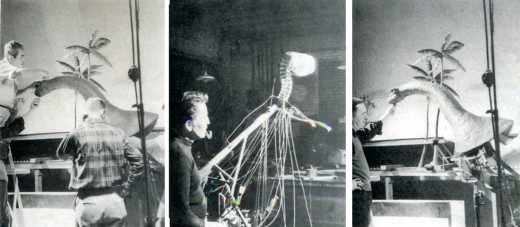
Project Unlimited technicians working on the large
manually-operated dinosaurs created for DINOSAURUS.
Left: Marcel Delgado applies the finishing touches to the Brontosaurus mockup.
Middle: Tom Holland and the Tyrannosaurs Rex “skeleton”.
CU: How big were the models in DINOSAURUS?
DS: Most of them were relatively small, except for the Brontosaurus, which was awfully big. You probably remember that we had a little doll of a boy riding on its back. I have a theory that large figures are hard to animate. Something happens, some strange phenomenon, which I can’t understand, takes place. I guess I’m not that kind of a perfect animator; I sort of do it loosely. I did TOM THUMB because that was all very contained. I got a lot out of the character as far as hand movements and so on. But the stuff that Jim Danforth did for BROTHERS GRIMM was just so superb that I would go insane doing that. I’m really into marionettes; I think that there’s a lot of potential in them for fantasy films in certain instances. I remember telling Gene Warren about some of those long shots where they were Trudging through the jungle in DINOSAURUS: “You know, I could do that better with marionettes.” I really think that one can augment the two.
CU: Project Unlimited also did some work on SPARTACUS…
DS: Yes, our little studio was always doing unusual props and effects for films, in between our animation jobs. Kirk Douglas was producing and starring in a monumental production of SPARTACUS, and Project Unlimited was called in to make about ‘ two or three hundred dead bodies, in various f scales, for some of the battle scenes. The largest * were about one-third life-size … We used molds to make them, and then we’d dress them in armor and sort of strew them all over the battlefields. I then i had to slash and “gore them up” with fake blood! We also made a bunch of horses out of polyure-thane foam. They weren’t very detailed, though-we just had to make sure they’d be recognizable from a distance, but none of them were shown in closeups.
CU: What did you do on THE TIME MACHINE?
DS: I worked on virtually all of the special effects.
There really wasn’t much animation, other than the decaying Morlock. That was done by Tom Holland. You know, I was in that film! I made my “screen debut.” Remember the guy in the window changing the clothes on the mannequin? That was me! I didn’t want the job because there was an actor there who worked with us, Dave Worrick. I asked them to give the job to Dave because I had no real desire to be in films. But they said, “No, we want you to do it.” So they got me a costume and animated me for the scenes.
CU: You mean you were actually pixillated as opposed to just speeding up the camera?
DS: Yes. I literally went in and they animated me per frame. The really neat thing about changing all of those costumes dealt with the fact that they were brought in from MGM. Somehow, in my subconscious mind, I recognized them. I remember saying to myself, “I’ll bet that’s a Lucille Ball dress.” Sure enough, it was, as their names are all sewn in them. But I loved the Morlock scenes. Some of the things I wish I had taken were a pair of Morlock feet and a Morlock head. They were great works of art; really spooky to look at! 1 animated the airplanes and dirigibles in the World War II scenes, but I never thought they were very realistic.
CU: In the earlier part of the film, there was a split-screen shot where boiling lava came oozing down the street. . .
DS: That was a great big fiasco, you know, because it didn’t really work. They had built these two bins full of colored oatmeal for the lava. One day, they decided to do a take. They covered all of the set with polyethylene. Now, they had prepared the oatmeal the night before, and nobody got up to look at it. Then they pulled the traps, with all these high-speed cameras going, and all the oatmeal had fermented and became watery. And the sight of all that! If I could have had a picture of the faces on those people! This foul-smelling, fermented mess came rushing down over all the cameras. I just went home. When they did the take again, they had put too much stuff together and it was too thick. I believe that’s how it appeared in the film. We were busy throwing burning cork and silvery material into the oatmeal, but it really didn’t work too well. It was fun, though.
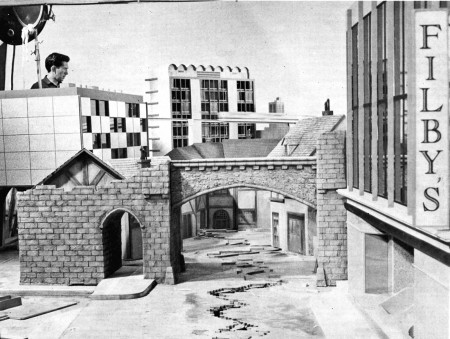
Don Sahlin on THE TIME MACHINE set.
Down this street will come the colored oatmeal “lava” flow.
CU: There was some inconsistency with the shot of you changing the mannequin. If the sun had been rising and setting at the speed depicted in the film, you shouldn’t have been able to see a man change a mannequin at all…
DS: Right. There are a lot of inconsistencies in that picture, but they’re very minor. It’s such a charming thing to watch. I never get tired of seeing it; it has such a haunting quality to it.
CU: Even the music and the actors seemed perfect.
DS: It did have a good score. Rod Taylor certainly seemed to be suited for the role. I had never been much of an Alan Young fan, but he played that triple role beautifully. And Yvette Mimieux was just out of high school at the time. The sound effects were great. I especially loved the off-camera sounds of the kettles underneath the ground.
CU: Did you work on the explosion scene towards the end?
DS: We had an incredible effect for that. We built a huge miniature set, about the size of a good-sized living room. It was all done on different levels of tables. We had legs underneath; and it was like a big puzzle. The legs were pulled at different times so the set would collapse. Then there would be explosions and flash-pots going off. It was really effective. There were many other scenes in THE TIME MACHINE that I worked on. There was the opening scene of the candles melting, and the ones of the flowers blooming. I remember we animated a snail; I also animated the Sphinx. You might recall the raising and lowering of those siren towers …
CU: Were they cardboard cutouts or was it a full miniature?
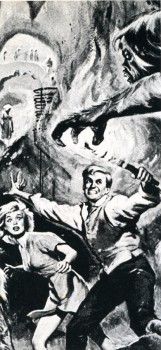 DS: It was dimensional. But there was very little animation involved in that. There was another scene, a blue-backing shot, where layers of lava were made to appear rising behind Rod Taylor in his Time Machine. That was all painted. They had a guy in another room, Bill Brace, an artist, and he was doing all those matte paintings where the trees were blooming and the apples were growing. And he painted the future scenes, too, where you saw the topography of the land changing, and the Eloi temple being built. The whole dome of that was a painting matted in, and the stairway leading up to it was part of MGM’s old QUO VADIS set.
DS: It was dimensional. But there was very little animation involved in that. There was another scene, a blue-backing shot, where layers of lava were made to appear rising behind Rod Taylor in his Time Machine. That was all painted. They had a guy in another room, Bill Brace, an artist, and he was doing all those matte paintings where the trees were blooming and the apples were growing. And he painted the future scenes, too, where you saw the topography of the land changing, and the Eloi temple being built. The whole dome of that was a painting matted in, and the stairway leading up to it was part of MGM’s old QUO VADIS set.
Do you know what I loved about working on TIME MACHINE? We literally did the sets ourselves. I loved doing the sets and dressing them. We were all very involved in the whole project instead of just one aspect of it. I remember working on that huge hole that Rod Taylor climbed into to get to the Morlock world. I loved getting down there, touching it up with a spray can and adding little details to it. I really feel proud to say that I worked on THE TIME MACHINE; I think it was a classic. I never received screen credit due to the politics of the organization, but it never bothered me. We were working on a very small budget. I think I remember Gene telling me that we did the effects for under $60,000, which was really a smal sum, yet it reaped an Academy Award. Have yot ever met George Pal?
CU: We’ve never had the pleasure.
DS: When you think about him, he was such an unusual producer when you realize the courage he had to have to do the kind of offbeat things he did.
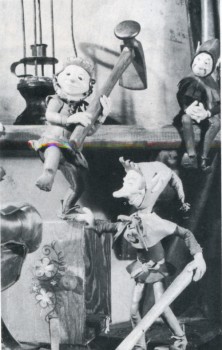 CU: The last film you worked on for him was THE WONDERFUL WORLD OF THE BROTHERS GRIMM. Could we talk about what you did on that one?
CU: The last film you worked on for him was THE WONDERFUL WORLD OF THE BROTHERS GRIMM. Could we talk about what you did on that one?
DS: I did a lot of the animation, especially the scenes involving the elves. The opening scene of the elves took me a whole week to do. Dave Pal and George’s other son, Peter, worked with me. We got along famously. I had to leave before the picture was over, so Dave carried on from where I left off.
CU: Did you work with Jim Danforth on the film?
DS: Not directly. I was in one corner of the stage, and Jim was working in the other corner. It was so tedious because of the Cinerama camera. Each frame had to be photographed three times. You had to be careful not to make any mistakes. We couldn’t talk at all. Peter would work the camera and we made it a point never to talk to each other because it was so easy to make an error. I was animating five elves, and he had to work that complicated turret camera.
CU: Didn’t you have to brace some of the elves? Some of them had to leap off the stage. . .
DS: Yes. We had a lot of wire stuff on the film. The wires were very thin and they were coated with iodine. You really couldn’t see them. Each time we’d reposition the puppet, the wires would be in a different part of the frame. So they really cancelled themselves out.
CU: Did anything unusual happen on the animation set?
DS: I do remember one funny thing that happened on BROTHERS GRIMM. There was a scene where an elf walked across the set with a shoe. The peg holes, by the way, were covered with clay and painted to match the set each time the elf took another step. Anyway, one of my little mice from the aborted TAILOR OF GLOUCESTER project got into a frame while the elf was being animated. Just for one frame. It was a terrible thing, but Pal never saw it!
CU: Did you do anything outside of the elf sequences?
DS: Wah Chang set up all of the shots and lit them. While he was doing that, I loaded the camera, which to this day frightens me because I don’t consider myself that technically inclined. I also did all of the calibrations and animated the camera for trucking shots. All the fades and the simpler opti-cals were done in the camera.
CU: Did you actually plot out all of the animation before it was photographed?
DS: We had to on some of the things. When there are faces involved as there were in TOM THUMB, and you have to do all the vowels and so on, you have to plot them out beforehand. But I like to animate sort of “free;” I don’t like to be restricted too much. You mentioned Jim Danforth before. I believe I met him while I was doing TOM THUMB. He was very young at the time and was very wide-eyed at what was going on. He seemed so impressed with our setup. Then I saw his reel that he had done in his garage. He did incredible stuff, op-ticals and everything. He’s a genius; he really is an incredible animator. He’s so much better than I am because I haven’t the patience to do the detail that he does. I remember him animating the dragon in BROTHERS GRIMM. He did that whole thing, and he spent days with all sorts of pointers. He’s a perfectionist.
CU: Now that you’re no longer involved in stop-motion, could you tell us about your work with the Muppets?
DS: I build and co-design Jim Henson’s puppets. He starts out with a little thumbnail sketch; I would say that he really creates the essence with his sketch. Then I start building it. Jim comes in and looks at it and we play with them to see how well they’ll work. But it’s really a joint effort, although I don’t do any of the puppeteering. I built many of the most famous of the Muppets. Kermit the frog, Bert and Ernie, the Cookie Monster, and most of the others.
CU: You did two “counting films” for Sesame Street. . . were these very recent?
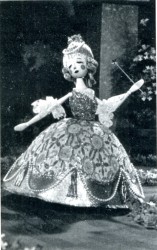 DS: Not really. They were done around 1970, right here in our Muppets, Inc. offices. Jim Henson supervised the filming, but he gave me all the freedom in the world to do what I wanted. THE QUEEN OF SIX was filmed on a rug, to simulate grass, and the backgrounds were all painted cardboard. The Queen figure was about 13 inches tall and I wanted her to have a very baroque, dresden sort of look. Her hoop skirt was a big lampshade that I put brocade on. She had a beautiful Marie Antoinette wig that I made out of silver thread, and I used one of those plastic Easter eggs you can buy for her head.
DS: Not really. They were done around 1970, right here in our Muppets, Inc. offices. Jim Henson supervised the filming, but he gave me all the freedom in the world to do what I wanted. THE QUEEN OF SIX was filmed on a rug, to simulate grass, and the backgrounds were all painted cardboard. The Queen figure was about 13 inches tall and I wanted her to have a very baroque, dresden sort of look. Her hoop skirt was a big lampshade that I put brocade on. She had a beautiful Marie Antoinette wig that I made out of silver thread, and I used one of those plastic Easter eggs you can buy for her head.
CU: I recall the other “counting film” you did, THE KING OF EIGHT, with the rhyme-speaking king, and his eight daughters opening and closing the windows of his castle. Both of these films were fairly short, weren’t they?
DS: Yes, none of those films done for Sesame Street are over a minute in length.
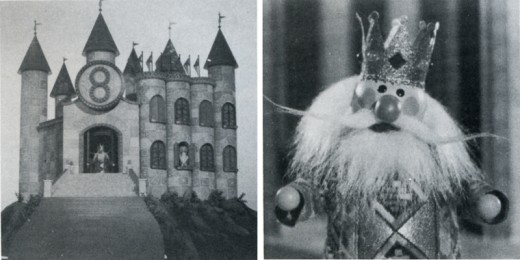
The King of Eights
CU: Are you satisfied with the work you’re doing now?
DS: Certainly. It’s very creative and enjoyable. I remember that when I was a kid, my sister wanted me to take regular college courses. I told her I wanted to take art courses. She would say, “What can you do with art? You’ll never make a living do ing puppets.” And it was only recently that we reminisced about that and, not trying to sound egotistical, I said to her: “Do you know that my puppets are all around the world?” Now that Sesame Street has been distributed in Europe, I have great satisfaction in knowing that my creations are
being seen and enjoyed internationally.
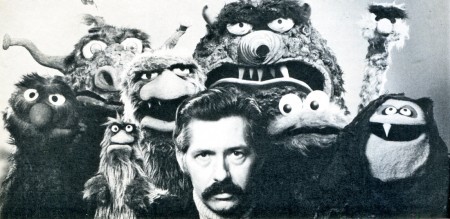
Don, as he appears today, with some of his more
“gruesome” creations for the Henson MUPPETS.

on 06 Apr 2010 at 9:52 am 1.Galen Fott said …
Fascinating interview! Thanks for posting.
on 06 Apr 2010 at 3:28 pm 2.Ken Priebe said …
Thank You Michael! Wonderful to read.
on 06 Apr 2010 at 3:58 pm 3.Michael said …
There’re other interviews there, with Kermit Love among others. I’ll try to post them all and get out more next week. I thought I’d posted them before, but I just went for the illustrations. The magazine’s layout is crazy, so I’m trying to sort it out and place one interview at a time. They’re all great.
on 07 Apr 2010 at 7:24 am 4.Pierre said …
Indeed, thanks very much for posting this. Articles like these are why I love this website.
I never knew Mr. Sahlin had such a diverse career outside the Henson organization! It’s nice to know I have seen his work in so many other productions.
I think it would be very interesting if a book were written about Projects Unlimited, as well as Cascade, both of which were training grounds for so many future effects and animation artists such as David Allen, David Muren, Mike Minor, Jim Danforth and so many others.
on 31 Dec 2015 at 8:43 am 5.David Moodie said …
What a fascinating article.So wonderful to learn about Don’s marvellous work-I recently watched “Hansel and Gretel” again and will put on “tom thumb” shortly.
How fabulous to see the little tom thumb marionette he created.I often wondered about that little puppet in the film.
I have been a professional puppeteer for many years,with my touring David’s Puppets,and Fairy Tale Theatre,but am now 65 and retired.
All good wishes to Don.
on 31 Dec 2015 at 3:05 pm 6.David Moodie said …
I have only just learned that Don had died in 1978.I feel very stupid.Sincere apologies.At least I got to learn about that wonderful clever man today-he was so much a part of many of my favourite fairytale fantasy films.
God Rest,Don.
from David.